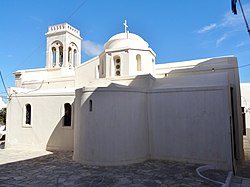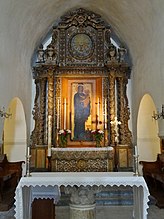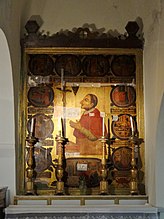Mitroppolitikos Naos Ypapantis tou Kyriou
| Mitroppolitikos Naos Ypapantis tou Kyriou | ||
|---|---|---|
 South side of the church building |
||
| Data | ||
| place | Chora (Naxos) | |
| Construction year | Early 13th century | |
| Coordinates | 37 ° 6 '22 " N , 25 ° 22' 37.4" E | |
|
|
||
| particularities | ||
| Former cathedral | ||
Mitroppolitikos Naos Ypapantis tou Kyriou ( modern Greek Μητροπολιτικός Ναός Υπαπαντής του Κυρίου 'Cathedral of the Presentation of the Lord') is the name of the Catholic Church and former cathedral in Chora on the Greek Cycladic island of Naxos . The church building stands on the highest point of the center of the island's capital called Kastro (Κάστρο) and belongs to the Archdiocese of Naxos, Andros, Tinos and Mykonos with its seat in Xinara on the island of Tinos .
history
The history of the church building begins with the construction of the Kastros at the beginning of the 13th century. After Constantinople was conquered at the Fourth Crusade , the territories of the Byzantine Empire that were won were divided up among the victors. The Duchy of Archipelagos , also called Duchy of Naxos, was founded in 1207 by the Venetian nobleman Marco Sanudo , a participant in the crusade and nephew of Doge Enrico Dandolo . To secure the duchy, the Venetian fort , now known as Kastro , was built, possibly on the foundation walls of an earlier Byzantine fortification.
The oldest building within the walls of the Kastros is the Orthodox Church Panagia Theoskepasti (Παναγία η Θεοσκέπαστη), probably from the 9th or 10th century. With the forcible introduction of Latin Christianity to the new ruling class , the Catholic cathedral was built to the northwest in front of the ducal palace, later the archbishop's palace . It initially consisted of the central nave with a dome and two side aisles . Two further aisles were added by 1536. Parts of the ancient acropolis and the unfinished Temple of Apollo, 500 meters away on the Palatia peninsula , of which the portara is still preserved as a symbol of Naxos, were used as building material for the cathedral and the entire Kastros .
The Duchy of Archipelagos existed until 1579, initially under the Sanudo dynasty, and from 1383 under the Crispo dynasty. The last duke was Marrane Joseph Nasi , appointed by Sultan Selim II in 1566 , who never entered Naxos. But even after that, the cathedral remained the religious center of the island's Catholics. The gravestones with the coats of arms of noble families and people, mostly of Venetian origin, such as the Barozzi, Crispi, Dambi, Frangopoulou, Grimaldi , Loredani, Giustiniani, de Raimond-Modène, Della Rocca and Sommaripa, are embedded in the floor of the church. During the period of Ottoman rule until the beginning of the 19th century, France saw itself under the Bourbons as the protective power of the Roman Catholic community. In 1915, water ingress caused great damage to the church building. Many tombstones, tombs and graves were lost. From the wooden pulpit only the portraits of the four evangelists remain today .
description

The Catholic Church stands directly in front of the smaller Orthodox Panagia Theoskepasti and thus covers it. The former cathedral is a five-aisled church building with a large dome in the middle and two smaller ones on the outer aisles. The entrance is on the west. There are four coats of arms incorporated above the lintel, of which the outer two, representing the ducal coats of arms of Marco Sanudo, are each half covered by a front facade. The inner coats of arms show a cross on the left and the lion of St. Mark on the right . The bell tower with flat roof and balustrade is located directly above the entrance . Both the west facade and the bell tower were clad in Tinos marble by Ioannes Phillipotes in 1963 .
The main or central nave of the former cathedral is oriented approximately from west to east, with the main altar in the east. The dome over the crossing rises on a round drum with four windows exactly in the middle of the church. The windows with baroque wood- carved elements were made in 1744 by two artists from Chios . The transept is only hinted at, the north and south transverse arms are parts of the inner aisles. The later built outer side aisles with the smaller domes adjoin these in the north and south. In contrast to the northern aisle, the southern outer aisle has an apse with a small window below the dome, which can be seen on the outer structure.
The interior of the church is laid out with Naxian marble. Numerous memorial stones from the 17th and 18th centuries with the coats of arms of Catholic nobles are embedded in the floors of the aisles. During the restoration of the church in 1972, four different columns from the 4th to 6th centuries, three of them made of granite, were discovered in the central nave, which had been under a layer of plaster and stone. In the middle of the nave are two paintings of the Holy Theoktiste (Theoktisti), one of them from the 16th century, the other more recent. The saint, who comes from Mithymna on Lesbos , is said to have lived as a hermit in the abandoned Katapoliani church on the then uninhabited island of Paros for about 35 years in the 9th century .
Behind the high altar of the central nave is the elaborate baroque reredos adorned at the top with a French lily under a crown with the image of the Merciful Virgin, also called Madonna the Gracious, from the 11th or 12th century. A legend tells that the icon of the Madonna fell into the sea at Nicomedia near the Bosporus and was washed ashore by the current on Naxos. The mother of God Mary is shown standing in the picture in the form of the Hodegetria , with the baby Jesus on her left arm. It is a double-sided icon with John the Baptist on the back . Since the restoration by the Byzantine and Christian Museum in Athens in 1970, during which various layers of paint were removed from overpainting, the double portrait has been hung in a rotating frame so that both sides can be viewed.
On the east side of the side aisle to the north of the nave is an altar of the Archangel Michael from the early 17th century. The altarpiece depicts the archangel in the armor of a Roman soldier , in his left hand a pair of scales, in the bowl of which lies his soul and his sins, in the right a sword with which he fights the devil. In the outer north aisle there is an altar with the image of the crucifixion of Christ , on which the kneeling Maria Magdalena appear below Jesus Christ and next to her are Saint John and the Virgin Mary . Above Jesus, God the Father and the Holy Spirit look down on him from a triangular image from the 16th century . In the side aisle south of the central nave there is an altar for Cardinal Charles Borromeo , who was canonized in November 1610 . The portrait shows him in profile and without a halo , an indication of the manufacture before canonization. Borromeo was the patron saint of the Capuchins and in 1539 was responsible for approving the order of the Ursulines by Pope Gregory XIII. Both orders maintained a monastery within the walls of the Kastros of Naxos.
 |
 |
 |

|
| High altar with Madonna |
Altar of the Archangel Michael |
Portrait of the crucifixion of Christ |
Altar for Charles Borromeo |
In the south aisle of the former cathedral there is an altar of the Virgin of the Rosary . The altar painting from 1916, made in the Byzantine style, shows the fifteen mysteries of the rosary above a tree of life with many branches . St. Dominic is on a pulpit under the tree in front of a crowd. The donors of the altar painting, a man and a woman, depicted in 17th century Naxian clothing, kneel below. In a side chapel of the nave there is an altar of Rochus de Montpellier . He appears there walking with his dog following him. The church also owns the rare icon of a galactotrophousa , a breastfeeding Mother of God.
Individual evidence
- ↑ Η Ποιμαντική ενότητα Μητροπόλεως Νάξου. www.cathecclesia.gr, archived from the original on December 17, 2014 ; Retrieved February 9, 2014 (Greek).
- ↑ a b Manolis Remoundos, Lefteris Karistineos: The Catholic Church of Naxos . Catholic Archdiocese of Naxos & Tinos, Naxos 2002, ISBN 960-87321-4-X , p. 6-13 .
- ^ Catholic Cathedral. www.naxos.gr, accessed on February 9, 2014 .
Web links
- Ο Μητροπολιτικός μας Ναός της Υπαπαντής του Κυρίου στη Νάξο. kantam.gr, accessed February 10, 2014 (Greek, Description of the Church - other languages in poor translation).
- Church of Presentation of the Lord. www.cathecclesia.gr, archived from the original on November 22, 2014 ; accessed on February 9, 2014 (English).
- Καθολική Μητρόπολη. www.naxos.gr, accessed February 9, 2014 (Greek, English ).



